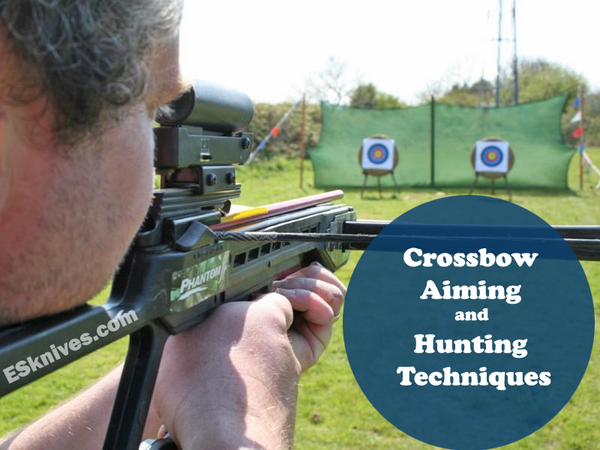Crossbow Aiming and Hunting Techniques

Crossbow Aiming and Hunting Techniques
- Always cock your crossbow consistently in the same place. Failure to do so can lead to off setting of your site. Marking your string while it is at rest with two marks on either side of the stock should remedy this problem.
- The accuarcy of the arrow is two dimensional. The proper combination of arrow and broadhead is needed.
- The smaller the broadhead the better the accuracy, in general.
- The task for the arrow is to correct any play the broadhead might introduce to the flight. It accomplishes this by spinning. A slight offset with straight clamps works very well.
- Trajectory is the key to any good shot. Remember most shots are under 20 yards. There's no point in shooting past that because the variation in the shot will vary too much for any regular sized target or game.
- Assuming you set your site at 20 yards then your trajectory will be one or two inches high at fifteen yards, and two or three inches low at twenty-five yards.
*Note: Care should be taken when shooting from a tree stand since the crossbow stock will kick in a upward direction. Make sure the area around your crossbow is clear of any limbs or other objects before firing.
History of the Crossbow
Literary and physical evidence suggest that the crossbow originated in China during the 4th century BC, though a type of crossbow called the gastraphetes may have been independently invented in Greece at about the same period. It wasn't until the 10th or 11th centuries AD that the crossbow became a significant military weapon in Europe. It passed from general military service in the 16th century, but its use for hunting and target shooting has continued to the present day. The most of following chronology is abridged from GUIDE TO THE CROSSBOW by Paterson:
| 341 BC | Earliest reliable record of crossbow use at battle of Ma-Ling in China. |
| 228 BC | Earliest crossbow artifact, a bronze lock mechanism from the tomb of Yu Wang. |
| 0-100 AD | Heron of Alexandria describes gastraphetes. |
| 300-700 | Roman carvings of crossbows. |
| 385 | Vegetius mentions crossbows in DE RE MILITARIA. |
| 1066 | Crossbows introduced to England by Normans. |
| 1096 | Anna Comnena describes Norman crossbows. |
| 1100-1200 | Composite crossbow lath appears. |
| 1139 | 2nd Lateran Council interdict forbids use of crossbow among Christians. |
| 1192 | Crusader victory at Jaffa aided by crossbows. |
| 1314 | Earliest reliable record of steel lath. |
| 1346 | Genoese crossbowmen defeated at Crecy by English longbowmen. |
| 1373 | Earliest illustration of cranequin. |
| 1503 | First of many English laws restricting possession and use of crossbows. |
| 1550-1600 | Firearms replace crossbows in most Weatern armies. |
| 1860 | Photographic evidence from Chinese shows repeating crossbows still used there as military weapons. |
| 1939-45 | "Arrowspeed" crossbow used by Austrailian commandos in Pacific Theatre. |
| 1945-1975 | Crossbows employed by Montagnard peoples and US special forces during Vietnam conflict. |
| 1960?-present | Crossbows used to shoot anesthetic darts for capturing and treating wildlife; also used to obtain tissue samples from marine animals for obtaining genetic information. |
Crossbow Terms
| ARBALIST | Latin language term for crossbow, derived from arcuballista (also spelled ARBALEST). |
| ARMBRUST | German language term for crossbow which is often preferred in international circles. |
| ARROW | Synonym for bolt which is preferred by some modern crossbow manufacturers. |
| BACK | Side of bow or lath facing target. |
| BALLISTA | Roman seige engine similar to oversized crossbow. |
| BARREL | Section of the stock between the latch and lath; sometimes used as synonym for track. |
| BARRELED CROSSBOW | Crossbow having a tubular barrel rather than a track; used to shoot balls, usually of lead; synonym for slurbow. |
| BASTARD STRING | String to brace a crossbow for installation of bowstring; synonym for bracing string. |
| BELLY | Side of bow or lath facing shooter. |
| BELT HOOK | Metal hook(s) attached to belt to aid cocking. |
| BENDING LEVER | Hindged lever to aid cocking; pushes string back using lugs or a ring mounted at front of crossbow; provides mechanical advantage of about 5:1, varying with lever length. |
| BINDING | See BRIDLE. |
| BOLT | Short projectile for crossbow resembling arrow. |
| BOLT CHANNEL | See TRACK. |
| BOW | See LATH. |
| BOW IRONS | Metal fittings used to secure lath to stock; usually tightened with metal wedges. |
| BOWSTEEL | Steel lath. |
| BOWSTRING | String used on all archery weapons to transfer force from bow to projectile. |
| BRACED | Position of bowstring when mounted on bow or lath, but not cocked. |
| BRACED HEIGHT | Distance between braced bowstring and belly side of riser, measured from the bowstring's center. |
| BRACING STRING | See BASTARD STRING. |
| BRIDLE | Binding, usually of twisted sinew cord, used to tie lath to stock on medieval crossbows. |
| BULLET CROSSBOW | Crossbow designed to shoot bullets; generally used in reference to double-string types. |
| BUTT | Rearmost portion of crossbow stock; also refers to earthen mound used in long range target shooting, and as a general term for backstop. |
| CATCH | See LATCH and SAFETY. |
| CENTER-SHOT | Bow or crossbow lath designed so that the arrow/bolt passes through its center; center-shot crossbows often have two separate limbs. |
| CLEAN DRAW | See POWER STROKE. |
| CLIP | Spring used to retain bolt to cocked crossbow prior to shooting; usually made of horn or metal. |
| CLOUT | Long range archery shooting. Modern practice uses a horizontal target 15 meters in diameter outlined with flags; scoring is determined by measuring distance from center. |
| COCK | To draw bowstring from braced position to latched position. |
| COCKING LUGS | Metal protruberances on crossbow for anchoring bending lever, cranequin or goat's foot. |
| COCKING PEG | Peg required to set some crossbow trigger mechanisms prior to cocking. |
| COCKING RING | Metal ring bound to the front of the lath to anchor bending lever. |
| COCKSCOMBING | Method of serving sometimes used on loops of crossbow bowstrings. |
| COMPOSITE | Combination of materials used to construct lath including horn, wood, sinew and baleen. |
| COMPOUND | Modern lath construction using cables and eccentric pulleys. |
| CORD AND PULLEY | Cocking aid consisting of cord with ends attached to crossbow butt and user's belt running through a pulley attached to bowstring; provides mechanical advantage of 2:1. |
| CRANEQUIN | Cocking device using rack and pinion; can provide mechanical advantage of about 145:1, varying with size and number of teeth. |
| CROSSBOW | Archery weapon consisting of a lath mounted to a rigid stock, having a mechanical means to hold and release the drawn bowstring. See also ARBALEST, ARMBRUST, BARRELED CROSSBOW, BULLET CROSSBOW. |
| DOG'S FOOT | See GOAT'S FOOT |
| DOUBLE STRING | Complex form of bowstring designed to launch round projectiles from crossbow; has leather pouch at center to hold ball. |
| DRY-FIRE | To release cocked bowstring without projectile; term borrowed from firearms. |








Comments